Spatiotemporal Characterization and Transfer Patterns of Aerosols and Trace Gases over the Region of Northeast China
Abstract
1. Introduction
2. Materials and Methods
2.1. Description of the Studied Area
2.2. Dataset
2.3. Categorization of Different Pollution Episodes
2.3.1. Haze Pollution
2.3.2. Complex Pollution
2.4. Potential Source Contribution Function (PSCF)
2.5. Data Processing and Analysis Methods
3. Results and Discussion
3.1. Annual Average Change of Pollutants
3.2. Monthly Mean Change in Pollutants
3.3. Principal Component Analysis
3.4. Haze Pollution and Compound Pollution
3.5. Meteorological Impact
3.6. Potential Source Contribution Function Analysis
4. Conclusions
Supplementary Materials
Author Contributions
Funding
Institutional Review Board Statement
Informed Consent Statement
Data Availability Statement
Acknowledgments
Conflicts of Interest
References
- Lin, T.; Qian, W.; Wang, H.; Feng, Y. Air Pollution and Workplace Choice: Evidence from China. Int. J. Environ. Res. Public Health 2022, 19, 8732. [Google Scholar] [CrossRef]
- Du, M.; Liu, W.; Hao, Y. Spatial Correlation of Air Pollution and Its Causes in Northeast China. Int. J. Environ. Res. Public Health 2021, 18, 10619. [Google Scholar] [CrossRef]
- Javed, Z.; Bilal, M.; Qiu, Z.; Li, G.; Sandhu, O.; Mehmood, K.; Wang, Y.; Ali, M.A.; Liu, C.; Wang, Y.; et al. Spatiotemporal characterization of aerosols and trace gases over the Yangtze River Delta region, China: Impact of trans-boundary pollution and meteorology. Environ. Sci. Eur. 2022, 34, 86. [Google Scholar] [CrossRef]
- Zheng, X.; Javed, Z.; Liu, C.; Tanvir, A.; Sandhu, O.; Liu, H.; Ji, X.; Xing, C.; Lin, H.; Du, D. MAX-DOAS and in-situ measurements of aerosols and trace gases over Dongying, China: Insight into ozone formation sensitivity based on secondary HCHO. J. Environ. Sci. 2024, 135, 656–668. [Google Scholar] [CrossRef]
- Qin, Y.; Li, J.; Gong, K.; Wu, Z.; Chen, M.; Qin, M.; Huang, L.; Hu, J. Double high pollution events in the Yangtze River Delta from 2015 to 2019: Characteristics, trends, and meteorological situations. Sci. Total Environ. 2021, 792, 148349. [Google Scholar] [CrossRef]
- Chen, L.; Chen, X.; Li, G. Analysis of Industrialization with Urbanization Interactive Course in Modern Northeast China. Urban Dev. Stud. 2004, 11, 28–31. [Google Scholar]
- Wang, T.; Du, H.; Zhao, Z.; Zhang, J.; Zhou, C. Impact of Meteorological Conditions and Human Activities on Air Quality During the COVID-19 Lockdown in Northeast China. Front. Environ. Sci. 2022, 10, 877268. [Google Scholar] [CrossRef]
- Mou, Y.; Song, Y.; Xu, Q.; He, Q.; Hu, A. Influence of Urban-Growth Pattern on Air Quality in China: A Study of 338 Cities. Int. J. Environ. Res. Public Health 2018, 15, 1805. [Google Scholar] [CrossRef]
- Yang, M.; Wang, W.; Li, Y.; Du, Y.; Tian, F. Revealing the Impact of Socio-Economic Metrics on the Air Quality on Northeast China Using Multivariate Statistical Analysis. Pol. J. Environ. Stud. 2022, 31, 3373–3385. [Google Scholar] [CrossRef]
- Shi, T.; Hu, Y.; Liu, M.; Li, C.; Zhang, C.; Liu, C. How Do Economic Growth, Urbanization, and Industrialization Affect Fine Particulate Matter Concentrations? An Assessment in Liaoning Province, China. Int. J. Environ. Res. Public Health 2020, 17, 5441. [Google Scholar] [CrossRef]
- Bai, L.; Li, C.; Yu, C.W.; He, Z. Air pollution and health risk assessment in Northeastern China: A case study of Jilin Province. Indoor Built Environ. 2021, 30, 1857–1874. [Google Scholar] [CrossRef]
- Wang, Y.; Guo, X. Spatiotemporal variation patterns and aggregation of crop residue burning at county scale in Northeast China. IOP Conf. Ser. Earth Environ. Sci. 2022, 1004, 012003. [Google Scholar] [CrossRef]
- Meng, C.; Cheng, T.; Bao, F.; Gu, X.; Wang, J.; Zuo, X.; Shi, S.J.A.; Research, A.Q. The Impact of Meteorological Factors on Fine Particulate Pollution in Northeast China. Aerosol Air Qual. Res. 2020, 20, 1618–1628. [Google Scholar] [CrossRef]
- Liu, H.; Chen, Y.; Qi, S.; Zhang, C. Chemical characteristics of precipitation in central Liaoning Province, Northeast China. Sci. Res. Essays 2012, 7, 3251–3261. [Google Scholar] [CrossRef]
- Meng, X.; Kc, S. Location choice of Air quality monitors in China. J. Environ. Manag. 2025, 373, 123496. [Google Scholar] [CrossRef]
- Wang, P. China’s air pollution policies: Progress and challenges. Curr. Opin. Environ. Sci. Health 2021, 19, 100227. [Google Scholar] [CrossRef]
- Gao, C.; Xing, C.; Tan, W.; Lin, H.; Bu, N.; Xue, J.; Liu, F.; Liu, W. Vertical characteristics and potential sources of aerosols over northeast China using ground-based MAX-DOAS. Atmos. Pollut. Res. 2023, 14, 101691. [Google Scholar] [CrossRef]
- Ma, Y.; Liu, Q.; Bian, Y.; Feng, L.; Zhao, D.; Wang, S.; Zhao, H.; Gao, K.; Xu, Z. Analysis of transport path and source distribution of winter air pollution in Shenyang. Open Geosci. 2021, 13, 1105–1117. [Google Scholar] [CrossRef]
- Zeng, Y.; Hopke, P.K. A study of the sources of acid precipitation in Ontario, Canada. Atmos. Environ. 1989, 23, 1499–1509. [Google Scholar] [CrossRef]
- Polissar, A.V.; Hopke, P.K.; Harris, J.M. Source Regions for Atmospheric Aerosol Measured at Barrow, Alaska. Environ. Sci. Technol. 2001, 35, 4214–4226. [Google Scholar] [CrossRef]
- Gao, H.; Wang, J.; Li, T.; Fang, C. Analysis of Air Quality Changes and Influencing Factors in Changchun during the COVID-19 Pandemic in 2020. Aerosol Air Qual. Res. 2021, 21, 210055. [Google Scholar] [CrossRef]
- Zhao, D.; Chen, H.; Yu, E.; Luo, T. PM2.5/PM10 Ratios in Eight Economic Regions and Their Relationship with Meteorology in China. Adv. Meteorol. 2019, 2019, 5295726. [Google Scholar] [CrossRef]
- Yue, D.L.; Hu, M.; Wu, Z.J.; Guo, S.; Wen, M.T.; Nowak, A.; Wehner, B.; Wiedensohler, A.; Takegawa, N.; Kondo, Y.; et al. Variation of particle number size distributions and chemical compositions at the urban and downwind regional sites in the Pearl River Delta during summertime pollution episodes. Atmos. Chem. Phys. 2010, 10, 9431–9439. [Google Scholar] [CrossRef]
- Li, X.; Chen, P.; Xie, Y.; Wang, Z.; Hopke, P.K.; Xue, C. Fine particulate matter and gas emissions at different burn phases from household coal-fired heating stoves. Atmos. Environ. 2023, 305, 119803. [Google Scholar] [CrossRef]
- Zhao, H.; Yang, G.; Xiu, A.; Zhang, X. A High Resolution Emission Inventory of Domestic Burning in Rural Region of Northeast China Based on Household Consumption. Chin. Geogr. Sci. 2020, 30, 921–933. [Google Scholar] [CrossRef]
- Chen, Y.; Shen, H.; Smith, K.R.; Guan, D.; Chen, Y.; Shen, G.; Liu, J.; Cheng, H.; Zeng, E.Y.; Tao, S. Estimating household air pollution exposures and health impacts from space heating in rural China. Environ. Int. 2018, 119, 117–124. [Google Scholar] [CrossRef]
- Li, L.; Li, Q.; Huang, L.; Wang, Q.; Zhu, A.; Xu, J.; Liu, Z.; Li, H.; Shi, L.; Li, R.; et al. Air quality changes during the COVID-19 lockdown over the Yangtze River Delta Region: An insight into the impact of human activity pattern changes on air pollution variation. Sci. Total Environ. 2020, 732, 139282. [Google Scholar] [CrossRef]
- Le, T.; Wang, Y.; Liu, L.; Yang, J.; Yung, Y.L.; Li, G.; Seinfeld, J.H. Unexpected air pollution with marked emission reductions during the COVID-19 outbreak in China. Science 2020, 369, 702–706. [Google Scholar] [CrossRef]
- Huang, X.; Ding, A.; Gao, J.; Zheng, B.; Zhou, D.; Qi, X.; Tang, R.; Wang, J.; Ren, C.; Nie, W.; et al. Enhanced secondary pollution offset reduction of primary emissions during COVID-19 lockdown in China. Natl. Sci. Rev. 2021, 8, nwaa137. [Google Scholar] [CrossRef]
- Brimblecombe, P.; Lai, Y. Effect of Fireworks, Chinese New Year and the COVID-19 Lockdown on Air Pollution and Public Attitudes. Aerosol Air Qual. Res. 2020, 20, 2318–2331. [Google Scholar] [CrossRef]
- Zhang, L.; Lee, C.S.; Zhang, R.; Chen, L. Spatial and temporal evaluation of long term trend (2005–2014) of OMI retrieved NO2 and SO2 concentrations in Henan Province, China. Atmos. Environ. 2017, 154, 151–166. [Google Scholar] [CrossRef]
- Xu, L.; Zou, Z.; Chen, J.; Fu, S. Effects of emission control areas on sulfur-oxides concentrations—Evidence from the coastal ports in China. Mar. Pollut. Bull. 2024, 200, 116039. [Google Scholar] [CrossRef]
- Jaeglé, L.; Steinberger, L.; Martin, R.V.; Chance, K. Global partitioning of NOx sources using satellite observations: Relative roles of fossil fuel combustion, biomass burning and soil emissions. Faraday Discuss. 2005, 130, 407–423. [Google Scholar] [CrossRef]
- Liu, F.; Zhang, Q.; Zheng, B.; Tong, D.; Yan, L.; Zheng, Y.; He, K. Recent reduction in NOx emissions over China: Synthesis of satellite observations and emission inventories. Environ. Res. Lett. 2016, 11, 114002. [Google Scholar] [CrossRef]
- Wang, Y.; Hu, B.; Tang, G.; Ji, D.; Zhang, H.; Bai, J.; Wang, X.; Wang, Y. Characteristics of ozone and its precursors in Northern China: A comparative study of three sites. Atmos. Res. 2013, 132–133, 450–459. [Google Scholar] [CrossRef]
- Yang, H.; Peng, Q.; Zhou, J.; Song, G.; Gong, X. The unidirectional causality influence of factors on PM2.5 in Shenyang city of China. Sci. Rep. 2020, 10, 8403. [Google Scholar] [CrossRef]
- Minoura, H. Some characteristics of surface ozone concentration observed in an urban atmosphere. Atmos. Res. 1999, 51, 153–169. [Google Scholar] [CrossRef]
- Li, M.; Wang, T.; Xie, M.; Zhuang, B.; Li, S.; Han, Y.; Song, Y.; Cheng, N. Improved meteorology and ozone air quality simulations using MODIS land surface parameters in the Yangtze River Delta urban cluster, China. J. Geophys. Res. Atmos. 2017, 122, 3116–3140. [Google Scholar] [CrossRef]
- Wang, H.; Lyu, X.; Guo, H.; Wang, Y.; Zou, S.; Ling, Z.; Wang, X.; Jiang, F.; Zeren, Y.; Pan, W.; et al. Ozone pollution around a coastal region of South China Sea: Interaction between marine and continental air. Atmos. Chem. Phys. 2018, 18, 4277–4295. [Google Scholar] [CrossRef]
- Liu, X.; Yan, J.; Wang, Z.; Pan, X.; Su, F.; Yan, J.; Niu, J. Factors driving changes in surface ozone in 44 coastal cities in China. Air Qual. Atmos. Health 2024, 17, 341–351. [Google Scholar] [CrossRef]
- Ren, S.; Ji, X.; Zhang, X.; Huang, M.; Li, H.; Wang, H. Characteristics and Meteorological Effects of Ozone Pollution in Spring Season at Coastal City, Southeast China. Atmosphere 2022, 13, 2000. [Google Scholar] [CrossRef]
- Zhang, Y.-L.; Cao, F. Fine particulate matter (PM2.5) in China at a city level. Sci. Rep. 2015, 5, 14884. [Google Scholar] [CrossRef]
- Hama, S.M.L.; Kumar, P.; Harrison, R.M.; Bloss, W.J.; Khare, M.; Mishra, S.; Namdeo, A.; Sokhi, R.; Goodman, P.; Sharma, C. Four-year assessment of ambient particulate matter and trace gases in the Delhi-NCR region of India. Sustain. Cities Soc. 2020, 54, 102003. [Google Scholar] [CrossRef]
- Xie, Y.H.; Han, X.W.; Sun, P.; Zhang, X.L. Analysis of Environmental Materials with Correlation between PM2.5 and Other Indexes in AQI of Wuhan. Adv. Mater. Res. 2014, 1003, 269–272. [Google Scholar] [CrossRef]
- Wang, Z.H.; Tian, Z.H. Analysis of Correlation Between PM2.5 and Major Pollutants by the Method of Path Analysis. In Proceedings of the 2018 International Symposium on Communication Engineering & Computer Science (CECS 2018), Hohhot, China, 28–29 July 2018; 2018; Volume 7, pp. 44–50. [Google Scholar] [CrossRef]
- Zhu, J.; Chen, L.; Liao, H.; Dang, R. Correlations between PM2.5 and Ozone over China and Associated Underlying Reasons. Atmosphere 2019, 10, 352. [Google Scholar] [CrossRef]
- Jia, M.; Zhao, T.; Cheng, X.; Gong, S.; Zhang, X.; Tang, L.; Liu, D.; Wu, X.; Wang, L.; Chen, Y. Inverse Relations of PM2.5 and O3 in Air Compound Pollution between Cold and Hot Seasons over an Urban Area of East China. Atmosphere 2017, 8, 59. [Google Scholar] [CrossRef]
- Zhou, L.; Sun, L.; Luo, Y.; Xia, X.; Huang, L.; Liao, Z.; Yan, X. Air pollutant concentration trends in China: Correlations between solar radiation, PM2.5, and O3. Air Qual. Atmos. Health 2023, 16, 1721–1735. [Google Scholar] [CrossRef]
- Sun, Y.; Zhuang, G.; Tang, A.; Wang, Y.; An, Z. Chemical Characteristics of PM2.5 and PM10 in Haze−Fog Episodes in Beijing. Environ. Sci. Technol. 2006, 40, 3148–3155. [Google Scholar] [CrossRef]
- Hao, T.; Chen, S.; Liu, J.; Tang, Y.; Han, S. An observational study on the impact of sea-land breeze and low-level jet on air pollutant transport in the Bohai Bay. Atmos. Pollut. Res. 2024, 15, 102143. [Google Scholar] [CrossRef]
- Requia, W.J.; Jhun, I.; Coull, B.A.; Koutrakis, P. Climate impact on ambient PM2.5 elemental concentration in the United States: A trend analysis over the last 30 years. Environ. Int. 2019, 131, 104888. [Google Scholar] [CrossRef]
- Tai, A.P.K.; Mickley, L.J.; Jacob, D.J. Correlations between fine particulate matter (PM2.5) and meteorological variables in the United States: Implications for the sensitivity of PM2.5 to climate change. Atmos. Environ. 2010, 44, 3976–3984. [Google Scholar] [CrossRef]
- Yang, Q.; Yuan, Q.; Li, T.; Shen, H.; Zhang, L. The Relationships between PM2.5 and Meteorological Factors in China: Seasonal and Regional Variations. Int. J. Environ. Res. Public Health 2017, 14, 1510. [Google Scholar] [CrossRef]
- Ge, Q.; Zhang, X.; Cai, K.; Liu, Y. Ozone Pollution in Chinese Cities: Spatiotemporal Variations and Their Relationships with Meteorological and Other Pollution Factors (2016–2020). Atmosphere 2022, 13, 908. [Google Scholar] [CrossRef]
- Wen, Y.; Xiao, J.; Yang, J.; Cai, S.; Liang, M.; Zhou, P. Quantitatively Disentangling the Geographical Impacts of Topography on PM2.5 Pollution in China. Remote Sens. 2022, 14, 6309. [Google Scholar] [CrossRef]
- Bei, N.; Zhao, L.; Wu, J.; Li, X.; Feng, T.; Li, G. Impacts of sea-land and mountain-valley circulations on the air pollution in Beijing-Tianjin-Hebei (BTH): A case study. Environ. Pollut. 2018, 234, 429–438. [Google Scholar] [CrossRef]
- Ding, A.; Wang, T.; Zhao, M.; Wang, T.; Li, Z. Simulation of sea-land breezes and a discussion of their implications on the transport of air pollution during a multi-day ozone episode in the Pearl River Delta of China. Atmos. Environ. 2004, 38, 6737–6750. [Google Scholar] [CrossRef]
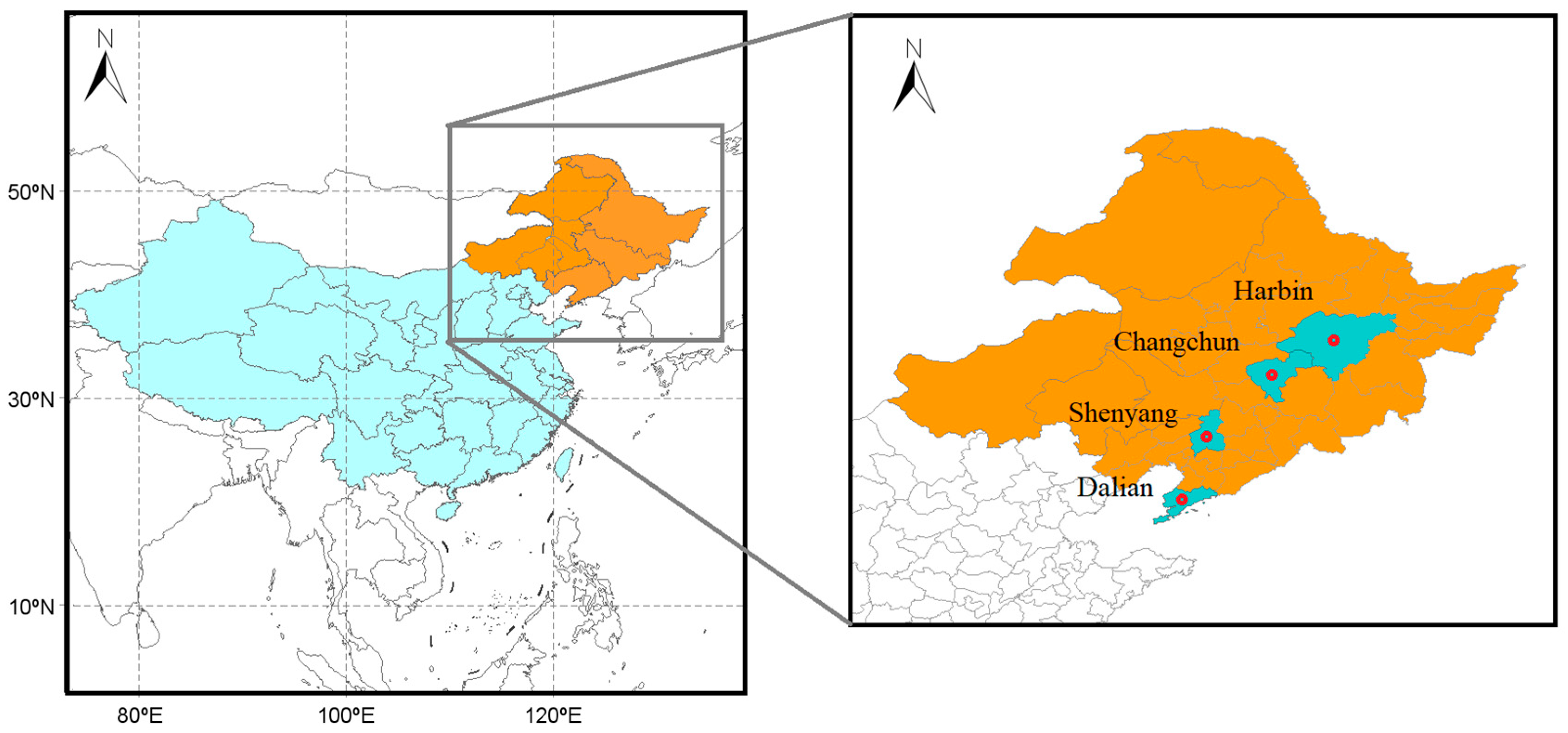

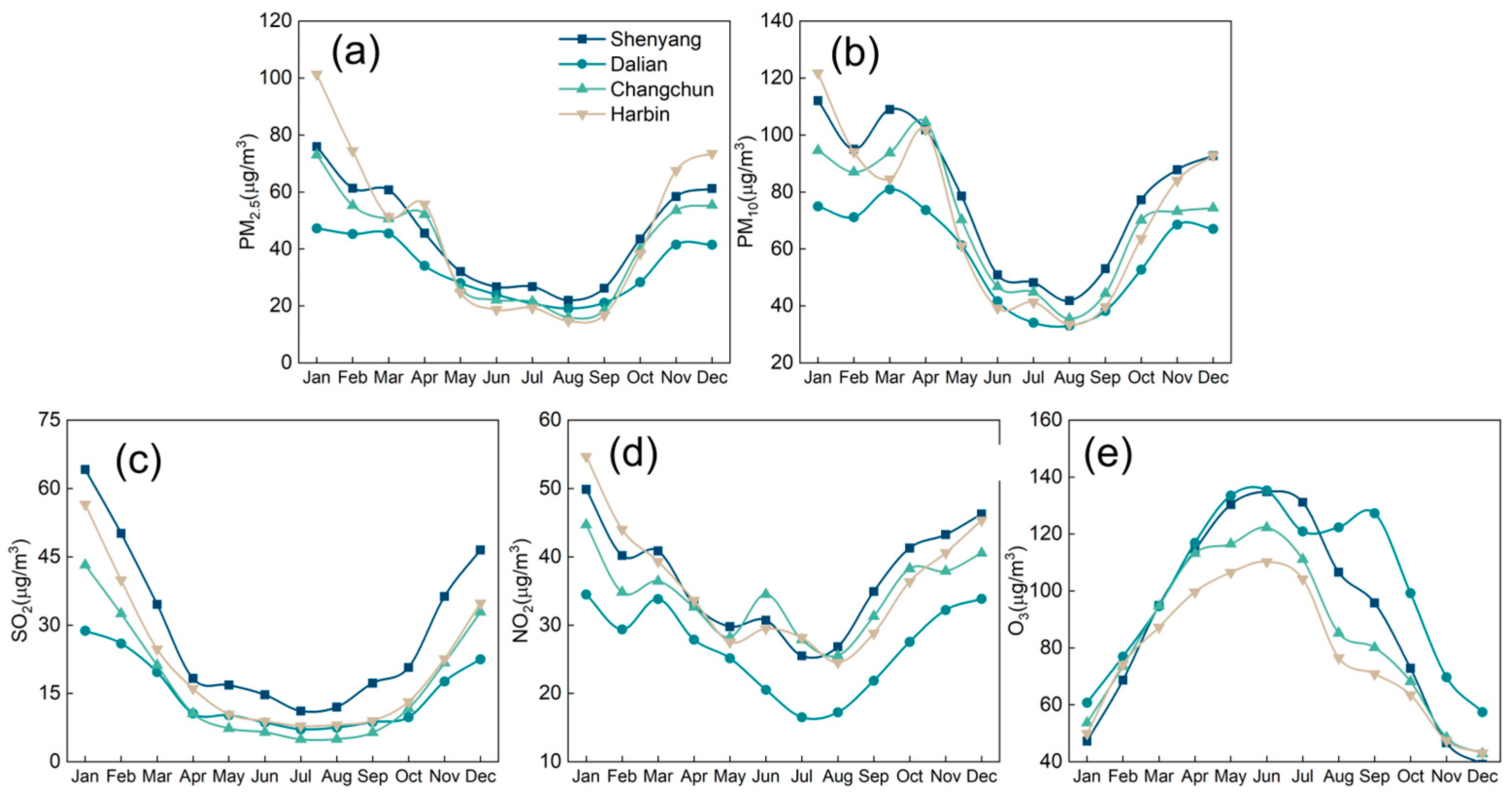


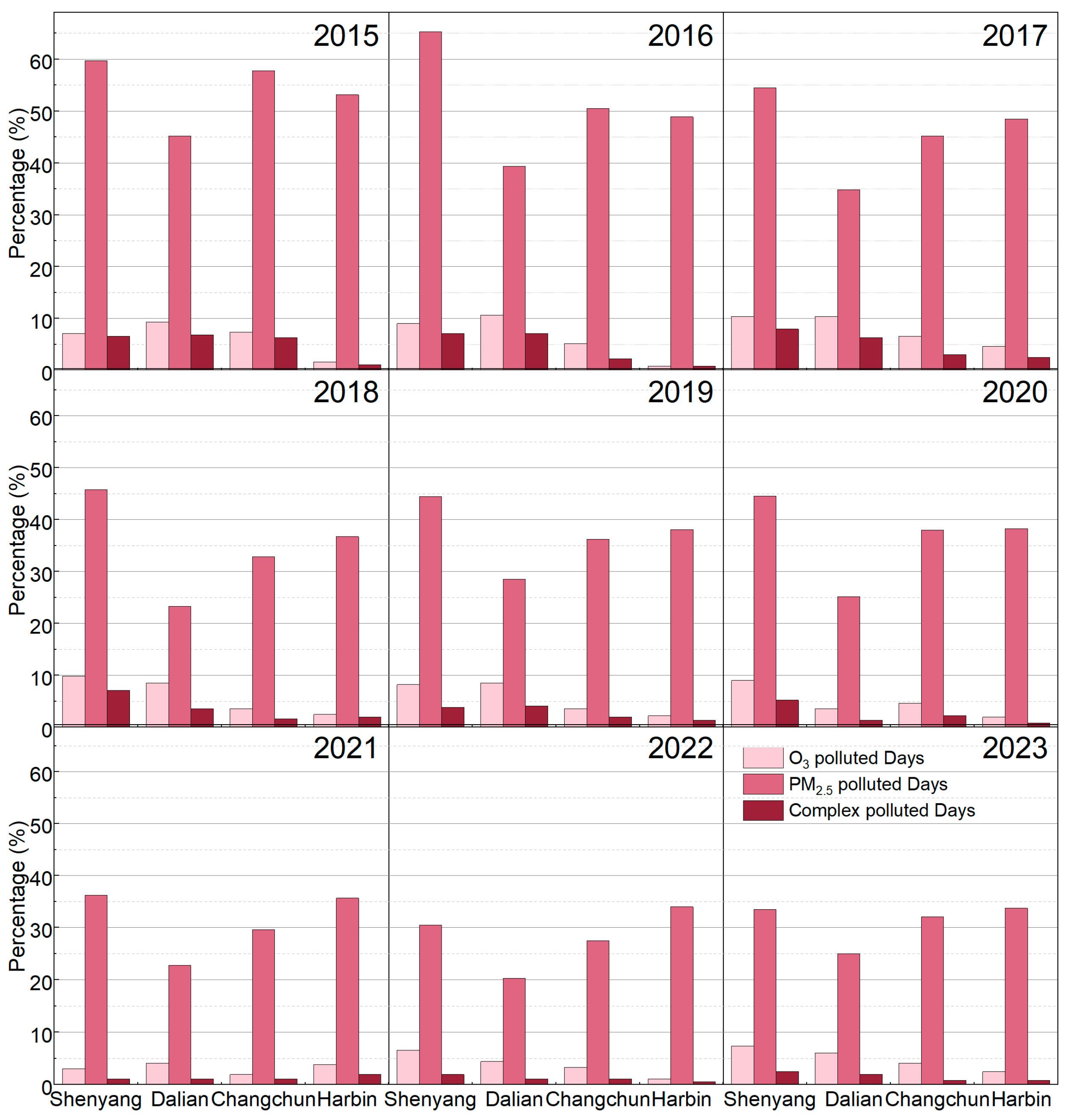
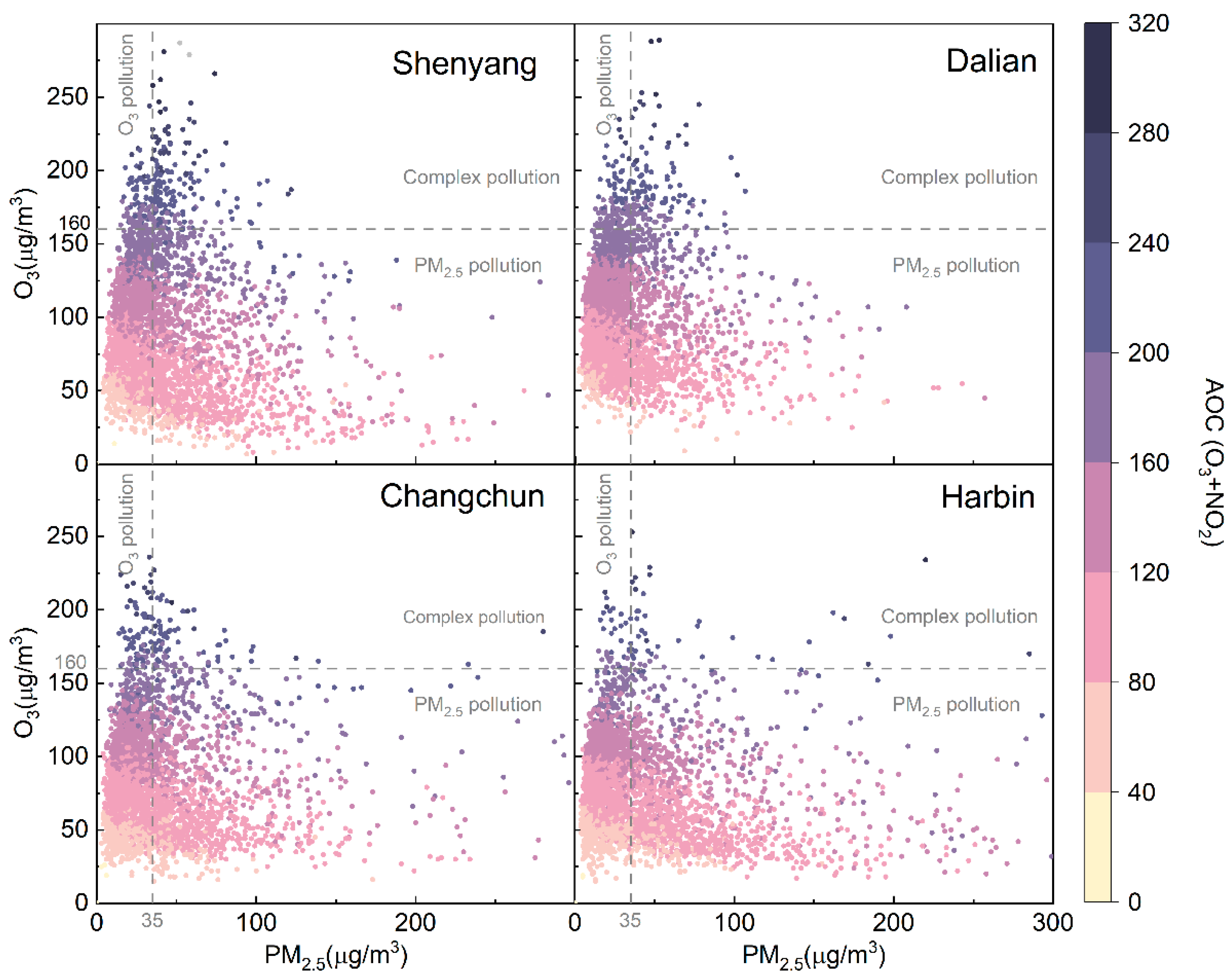
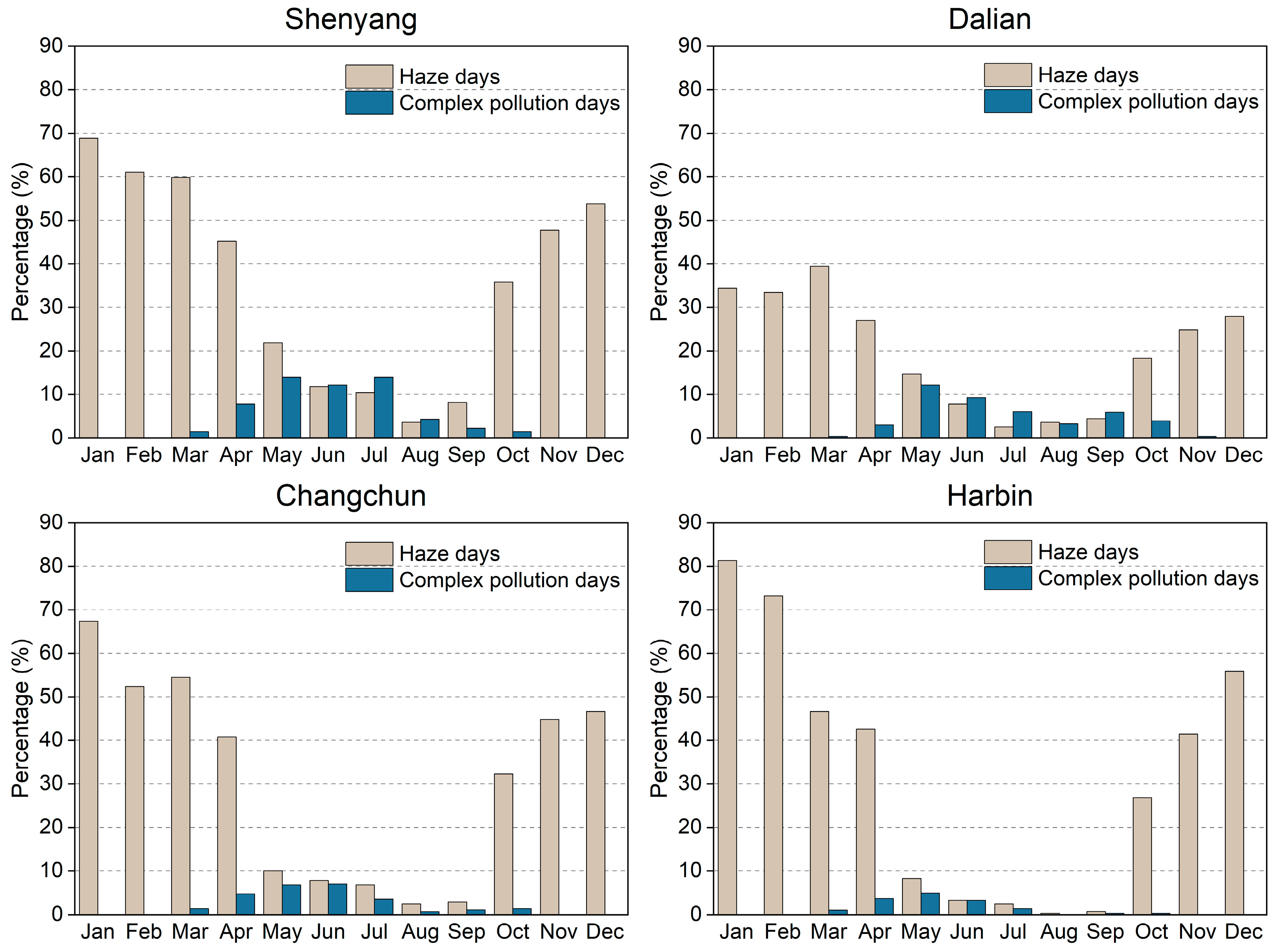




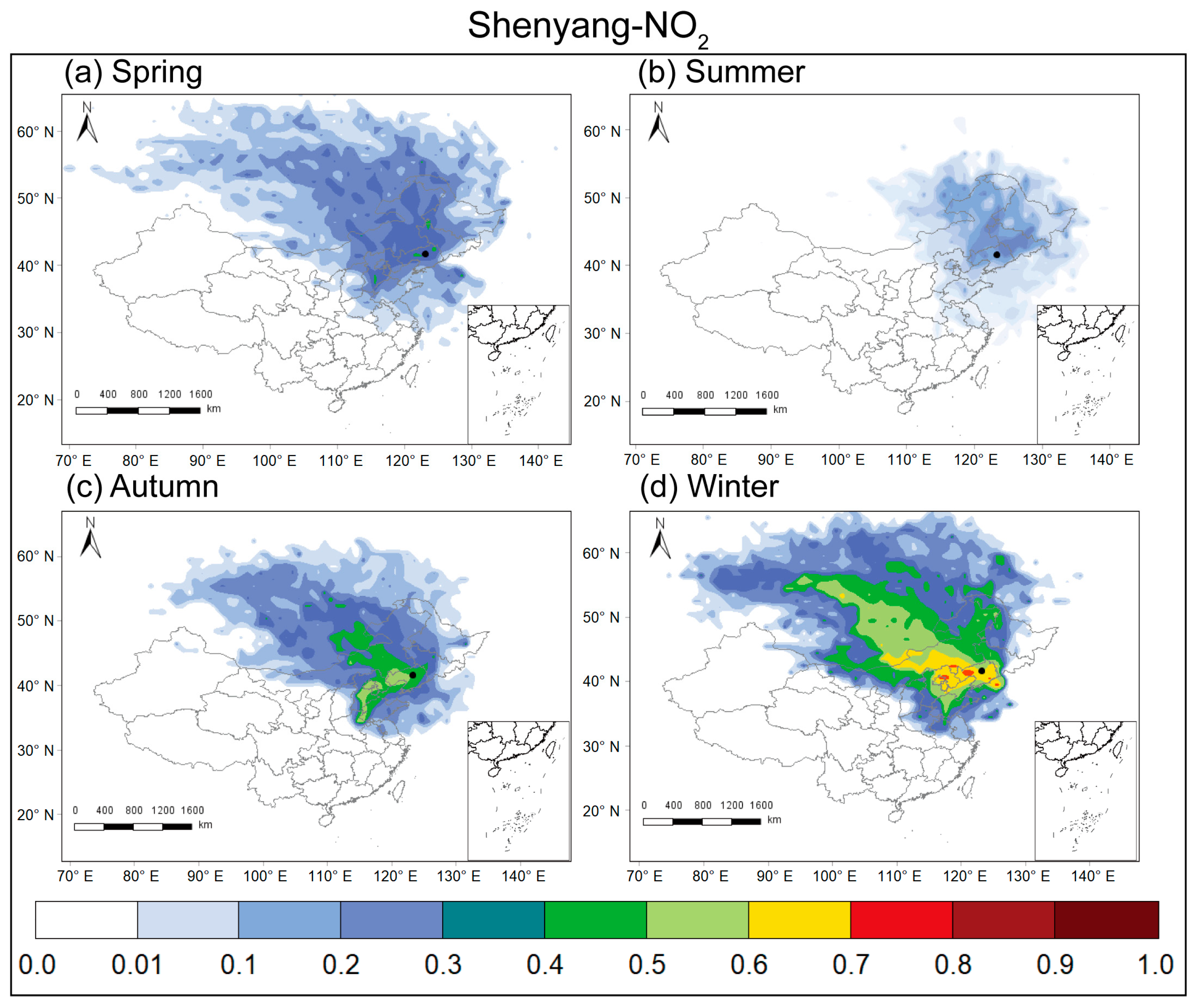
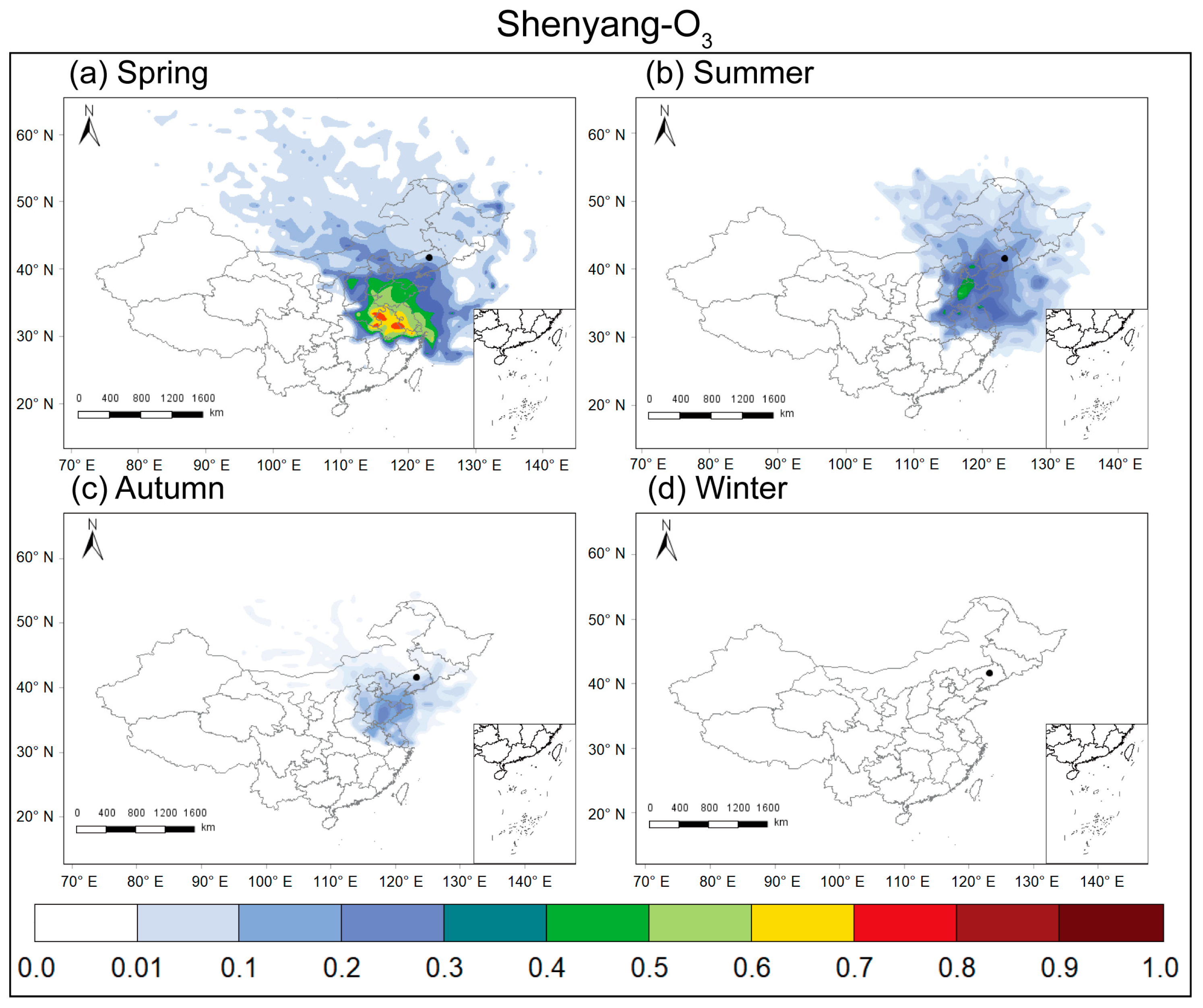

Disclaimer/Publisher’s Note: The statements, opinions and data contained in all publications are solely those of the individual author(s) and contributor(s) and not of MDPI and/or the editor(s). MDPI and/or the editor(s) disclaim responsibility for any injury to people or property resulting from any ideas, methods, instructions or products referred to in the content. |
© 2025 by the authors. Licensee MDPI, Basel, Switzerland. This article is an open access article distributed under the terms and conditions of the Creative Commons Attribution (CC BY) license (https://creativecommons.org/licenses/by/4.0/).
Share and Cite
Gao, C.; Xing, C.; Tan, W.; Bu, N.; Liu, W. Spatiotemporal Characterization and Transfer Patterns of Aerosols and Trace Gases over the Region of Northeast China. Atmosphere 2025, 16, 1258. https://doi.org/10.3390/atmos16111258
Gao C, Xing C, Tan W, Bu N, Liu W. Spatiotemporal Characterization and Transfer Patterns of Aerosols and Trace Gases over the Region of Northeast China. Atmosphere. 2025; 16(11):1258. https://doi.org/10.3390/atmos16111258
Chicago/Turabian StyleGao, Changyuan, Chengzhi Xing, Wei Tan, Naishun Bu, and Wenqing Liu. 2025. "Spatiotemporal Characterization and Transfer Patterns of Aerosols and Trace Gases over the Region of Northeast China" Atmosphere 16, no. 11: 1258. https://doi.org/10.3390/atmos16111258
APA StyleGao, C., Xing, C., Tan, W., Bu, N., & Liu, W. (2025). Spatiotemporal Characterization and Transfer Patterns of Aerosols and Trace Gases over the Region of Northeast China. Atmosphere, 16(11), 1258. https://doi.org/10.3390/atmos16111258







